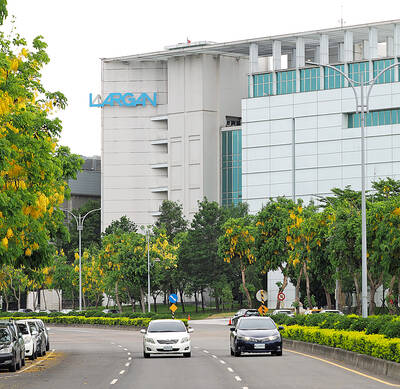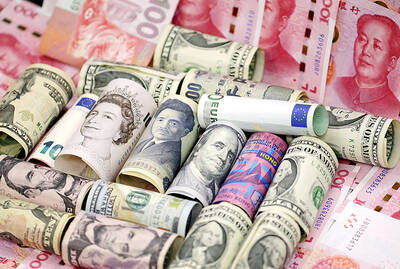Yang Ming Marine Transport Corp (陽明海運) has posted a widened quarterly loss for last quarter after a strategic decision not to exercise options with respect to two formerly chartered vessels cost it NT$1.38 billion (US$45.19 million).
Last quarter’s net loss deepened to NT$1.37 billion, compared with a net loss of NT$909 million in the same period last year.
That translated into losses per share of NT$0.53, it said.
Keelung-based Yang Ming has been struggling to turn a profit after it returned to the black briefly in the fourth quarter last year.
The shipping company sold two 8,200 twenty-foot-equivalent-unit container vessels to a leasing company in 2008 and 2009, then immediately leased them back, it said in a filing with the Taiwan Stock Exchange.
The leases included purchase options on the two vessels at the end of the term, for which Yang Ming paid a deposit, the company said.
With the leases due to expire at the end of this year, the company decided not to exercise the options, as it would be more economical to buy new vessels, it said.
The deposit should have been returned when Yang Ming decided not to exercise the options, but the lessor is in a distressed financial situation, so Yang Ming recognized the estimated loss of NT$1.38 billion in its accounts to comply with international accounting rules, it said.
In the first three quarters of the year, Yang Ming’s cumulative net loss shrank 50 percent year-on-year to NT$3.32 billion, or losses per share of NT$1.28, it said.
Yang Ming is conservative about this quarter, as global cargo demand is forecast to remain weak due to geopolitical tensions and a US-China trade dispute, it said, citing a forecast by Paris-based maritime consultancy Alphaliner.
However, the company is more upbeat about next year, as growth in supply is expected to slow following the implementation of the International Maritime Organization’s regulation that requires ships to use fuel with a maximum 0.5 percent sulfur content, it said.
Meanwhile, Wan Hai Lines Ltd (萬海航運) posted a net profit of NT$650 million for last quarter, an increase of 51 percent year-on-year driven by rising revenue and solid management of costs, company spokeswoman Laura Su (蘇麗梅) said by telephone.
Gross margin improved to 9.53 percent last quarter, compared with 7.03 percent a year earlier, Su said.
The Taipei-based company posted a cumulative net profit of NT$2.39 billion for the first nine months, or earnings per share of NT$1.08, an 85 percent year-on-year increase, Su said.
Wan Hai, which makes 70 percent of its revenue on intra-Asia routes, expects the growth momentum to continue into this quarter, despite an ongoing US-China trade dispute, as it has gained orders from its Chinese clients, Su added.

Handset camera lens maker Largan Precision Co (大立光) on Sunday reported a 6.71 percent year-on-year decline in revenue for the third quarter, despite revenue last month hitting the highest level in 11 months. Third-quarter revenue was NT$17.68 billion (US$581.2 million), compared with NT$18.95 billion a year earlier, the company said in a statement. The figure was in line with Yuanta Securities Investment Consulting Co’s (元大投顧) forecast of NT$17.9 billion, but missed the market consensus estimate of NT$18.97 billion. The third-quarter revenue was a 51.44 percent increase from NT$11.67 billion in the second quarter, as the quarter is usually the peak

Taiwan’s foreign exchange reserves hit a record high at the end of last month, surpassing the US$600 billion mark for the first time, the central bank said yesterday. Last month, the country’s foreign exchange reserves rose US$5.51 billion from a month earlier to reach US$602.94 billion due to an increase in returns from the central bank’s portfolio management, the movement of other foreign currencies in the portfolio against the US dollar and the bank’s efforts to smooth the volatility of the New Taiwan dollar. Department of Foreign Exchange Director-General Eugene Tsai (蔡炯民)said a rate cut cycle launched by the US Federal Reserve

The US government on Wednesday sanctioned more than two dozen companies in China, Turkey and the United Arab Emirates, including offshoots of a US chip firm, accusing the businesses of providing illicit support to Iran’s military or proxies. The US Department of Commerce included two subsidiaries of US-based chip distributor Arrow Electronics Inc (艾睿電子) on its so-called entity list published on the federal register for facilitating purchases by Iran’s proxies of US tech. Arrow spokesman John Hourigan said that the subsidiaries have been operating in full compliance with US export control regulations and his company is discussing with the US Bureau of

Pegatron Corp (和碩), a key assembler of Apple Inc’s iPhones, on Thursday reported a 12.3 percent year-on-year decline in revenue for last quarter to NT$257.86 billion (US$8.44 billion), but it expects revenue to improve in the second half on traditional holiday demand. The fourth quarter is usually the peak season for its communications products, a company official said on condition of anonymity. As Apple released its new iPhone 17 series early last month, sales in the communications segment rose sequentially last month, the official said. Shipments to Apple have been stable and in line with earlier expectations, they said. Pegatron shipped 2.4 million notebook